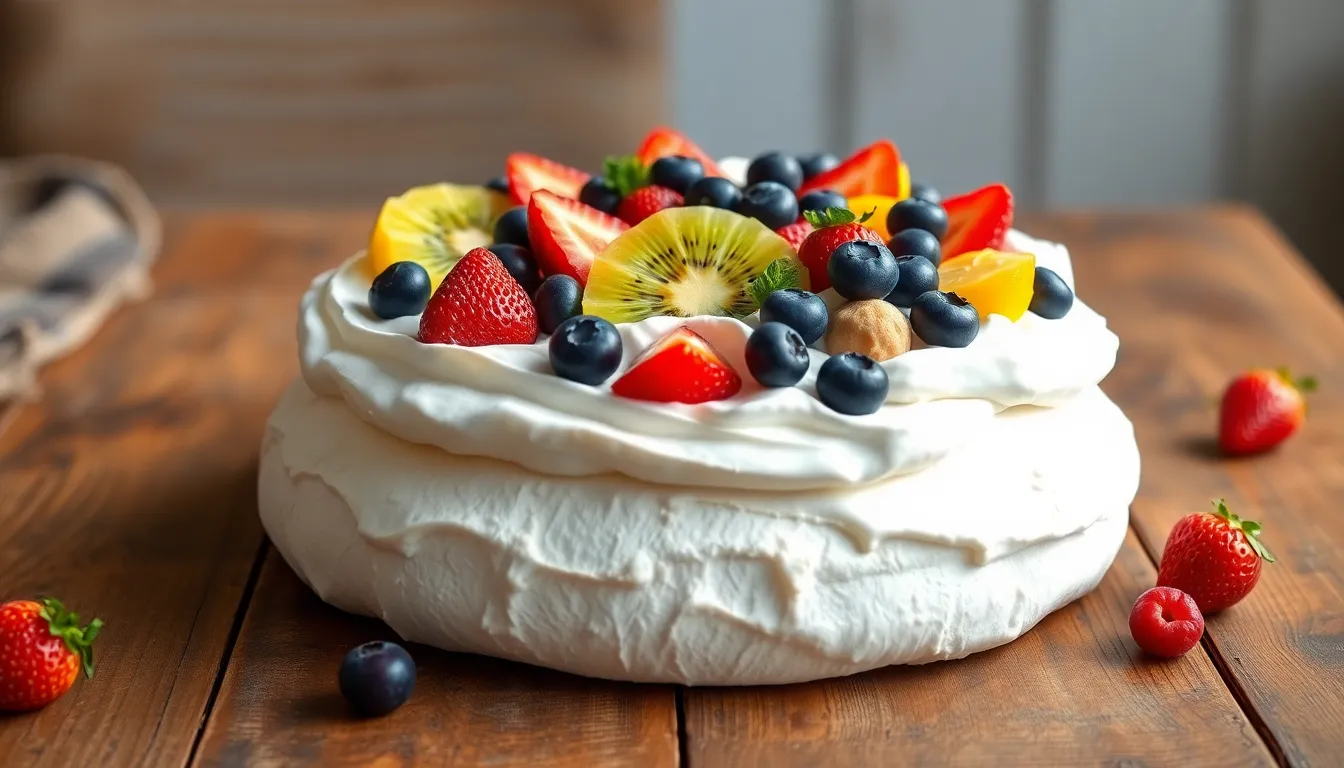Is pavlova gluten free? Yes! This delicate, cloud-like dessert naturally contains no gluten, making it perfect for those with celiac disease or gluten sensitivity.
Pavlova’s airy meringue base is crafted from just egg whites, sugar, cornstarch, and vinegar—all naturally gluten-free ingredients. The magic happens as these simple components transform into a dessert with a crisp exterior and marshmallow-soft center. You’ll find no wheat, barley, or rye hiding in this elegant treat.
When topped with fresh whipped cream and seasonal fruits, pavlova becomes a stunning centerpiece that everyone at your table can enjoy without worry. Just be cautious with store-bought versions or restaurant offerings, as cross-contamination is always a possibility. Making your own pavlova at home ensures you maintain complete control over ingredients for a truly gluten-free experience.
What Is Pavlova?
Pavlova is a meringue-based dessert named after the Russian ballerina Anna Pavlova. This iconic dessert originated in either Australia or New Zealand (both countries claim it) during the 1920s following one of the dancer’s tours to the region.
The traditional pavlova consists of a crisp meringue shell with a marshmallow-soft center topped with whipped cream and fresh fruits. Its signature texture comes from the unique preparation method that creates a contrast between the crunchy exterior and cloud-like interior.
The base of pavlova is made by whipping egg whites until stiff peaks form then gradually incorporating sugar until the mixture becomes glossy and thick. A small amount of acid (typically vinegar or lemon juice) and cornstarch are added to stabilize the meringue structure. These ingredients work together to create the pavlova’s distinctive texture – crisp on the outside yet soft and almost marshmallow-like on the inside.
What sets pavlova apart from other meringue desserts is its size and serving style. Unlike small meringue cookies, pavlova is typically made as a large cake-sized dessert meant for sharing. The hollow center creates the perfect nest for generous amounts of whipped cream and seasonal fruits like strawberries, kiwi, passion fruit, or berries.
This elegant dessert has become a staple at holiday gatherings and special occasions throughout Australia, New Zealand, and increasingly around the industry. Its naturally gluten-free ingredient list makes it an excellent choice for those with celiac disease or gluten sensitivity when made with proper precautions against cross-contamination.
Is Pavlova Gluten Free?

Yes pavlova is naturally gluten free making it an excellent dessert option for those with celiac disease or gluten sensitivity. The classic meringue-based dish contains no wheat barley or rye products. All primary ingredients in traditional pavlova recipes are completely free from gluten including:
- Egg whites
- Superfine sugar
- Cornstarch (cornflour)
- Vinegar or cream of tartar
- Vanilla extract
This beloved dessert features a crisp exterior with a soft marshmallow-like interior that everyone can enjoy regardless of gluten restrictions. Cornstarch helps create the characteristic texture without introducing any gluten to the recipe. Both Australian and New Zealand cuisines widely recognize pavlova as a naturally gluten-free treat.
Store-bought versions might pose cross-contamination risks so preparing pavlova at home ensures complete control over ingredients and preparation surfaces. When making pavlova be sure to check that your vanilla extract is pure and not containing any gluten-based additives. Your homemade pavlova provides a safe indulgent dessert that naturally accommodates gluten-free dietary needs without sacrificing flavor or texture.
Ingredients For Gluten Free Pavlova

Creating a delicious pavlova requires just a handful of naturally gluten-free ingredients. You can easily prepare this elegant dessert without worrying about gluten exposure since all components are inherently free from wheat proteins.
Essential Ingredients
- 4-5 large egg whites (room temperature)
- 1 cup superfine sugar (caster sugar)
- 1 tablespoon cornstarch (corn flour)
- 1 teaspoon white vinegar
- 1 teaspoon pure vanilla extract
- ¼ teaspoon cream of tartar (optional, helps stabilize the meringue)
These basic ingredients work together to create the signature pavlova texture—crisp on the outside with a soft marshmallow center. Room temperature egg whites will whip to greater volume than cold ones. Superfine sugar dissolves more readily into the egg whites resulting in a smoother meringue. Cornstarch contributes to the characteristic chewy interior while remaining completely gluten-free.
Optional Toppings
- 1½ cups heavy whipping cream
- 2 tablespoons powdered sugar
- 1 teaspoon vanilla extract
- 3 cups fresh fruit (strawberries, kiwi, raspberries, blueberries)
- Passion fruit pulp
- Lemon curd
- Fruit compotes
- Fresh mint leaves for garnish
Whipped cream creates a luscious layer between the meringue and fruit toppings. Fresh seasonal fruits add beautiful color contrast and complement the sweetness of the meringue perfectly. You should arrange your toppings just before serving to prevent the pavlova from becoming soggy. Passion fruit adds a tangy element that balances the overall sweetness of the dessert. All these toppings maintain the gluten-free integrity of your pavlova while improving its visual appeal and flavor complexity.
Equipment Needed
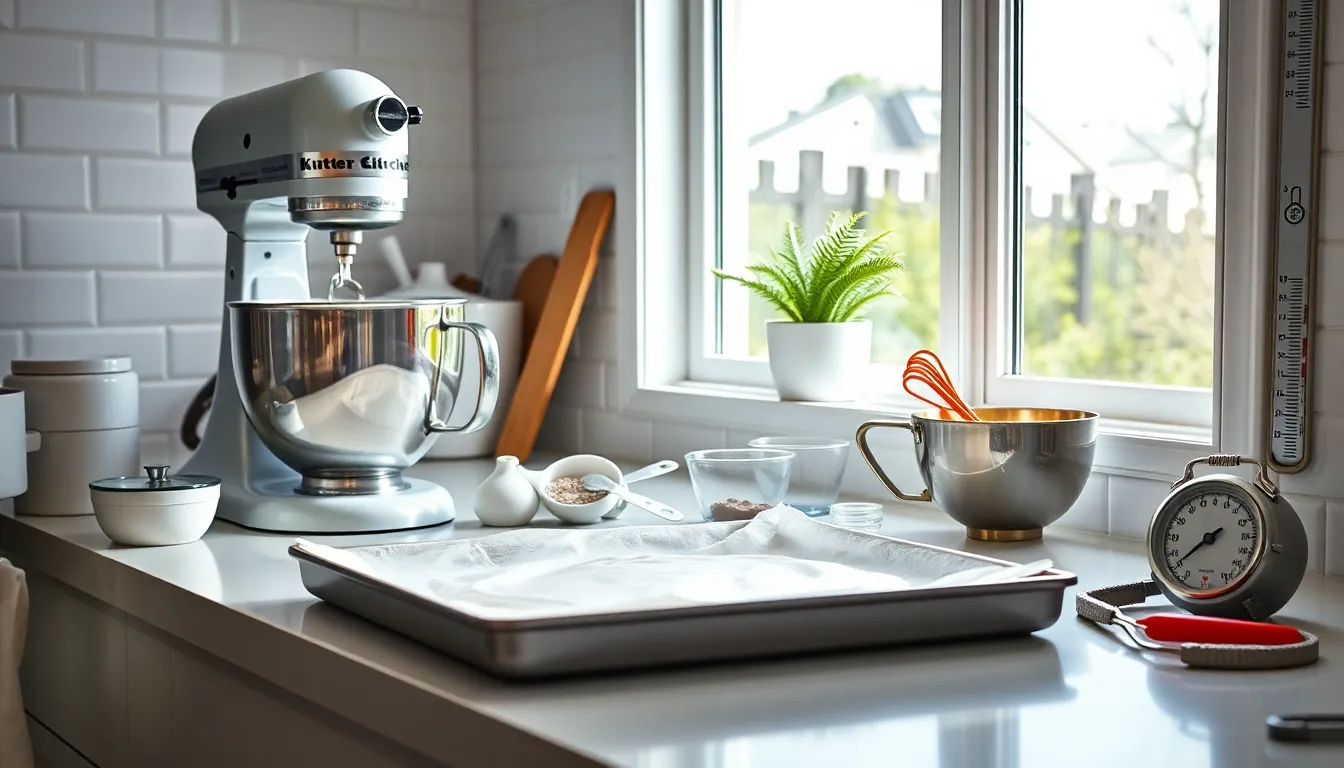
Creating a perfect gluten-free pavlova requires just a few exact kitchen tools to ensure success. Here’s everything you’ll need to prepare this delicate meringue-based dessert:
- Stand mixer or hand mixer – Essential for whipping egg whites to stiff peaks; while possible to whip by hand, an electric mixer saves important time and effort
- Large mixing bowl – Preferably metal or glass for better stability when whipping egg whites
- Measuring cups and spoons – For precise ingredient measurements
- Baking sheet – A flat tray for baking your pavlova
- Parchment paper – Creates a non-stick surface that helps prevent your pavlova from sticking
- Spatula – Rubber or silicone for gently folding in cornstarch and other ingredients
- Pencil and dinner plate – To trace a circle on parchment paper as a guide for shaping your pavlova
- Oven thermometer – Helps ensure accurate oven temperature for proper baking
- Cooling rack – Allows air to circulate around the pavlova after baking
Using clean equipment is particularly important when making pavlova. Any grease or residue on your mixing bowl or beaters can prevent egg whites from whipping properly. Washing your equipment with hot soapy water and drying thoroughly before use helps guarantee your gluten-free pavlova will achieve the perfect texture with its signature crisp exterior and marshmallowy center.
How To Make Gluten Free Pavlova
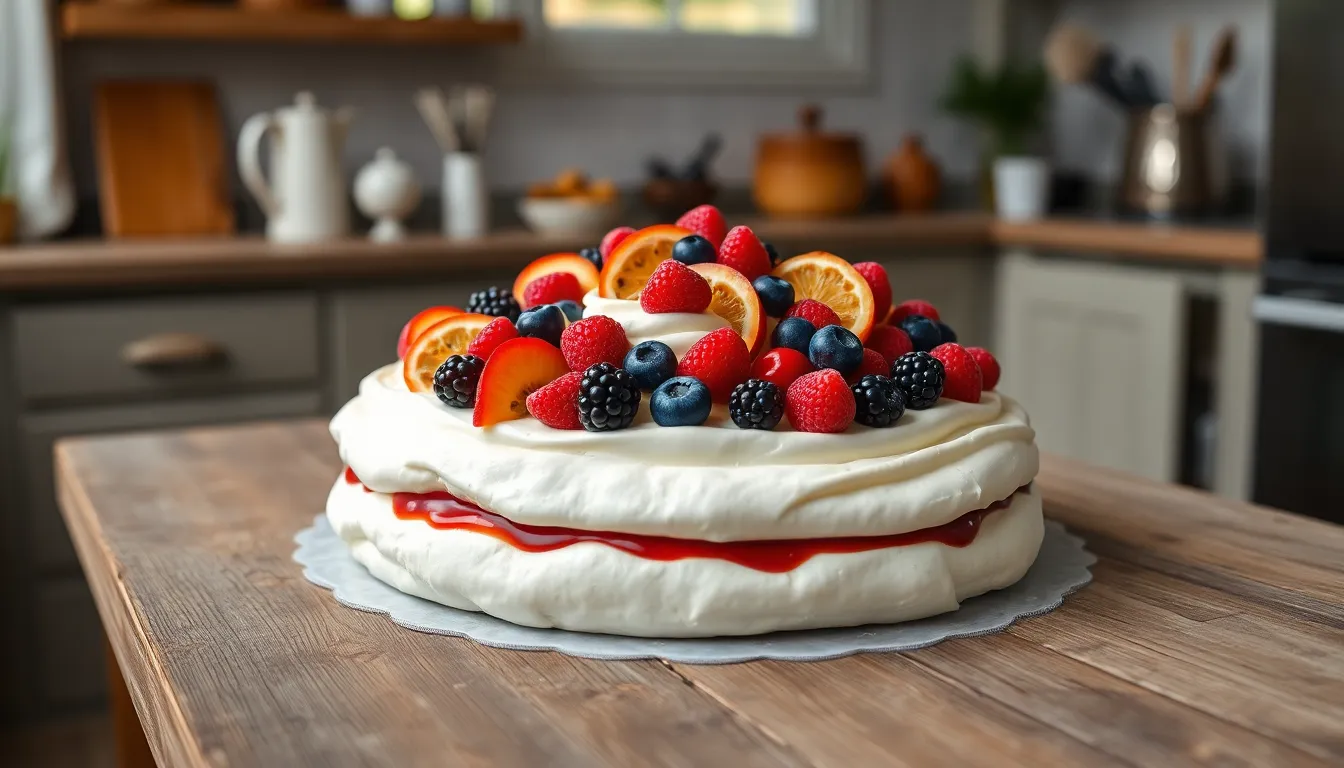
Creating a perfect pavlova is an art that combines simple ingredients to produce a dessert with a delightful contrast of textures. This naturally gluten free treat requires attention to detail but rewards you with a stunning centerpiece for any occasion.
Preparing The Meringue
- 4-5 large egg whites at room temperature
- Pinch of salt
- 1/2 teaspoon cream of tartar (optional)
- 1 cup superfine (caster) sugar
- 1 teaspoon vanilla extract
- 1 teaspoon cornstarch
Begin by bringing your egg whites to room temperature for optimal volume. Separate them carefully, ensuring no yolk contaminates the whites. In a completely clean, dry mixing bowl, beat the egg whites with a pinch of salt and cream of tartar until soft peaks form. Gradually add the superfine sugar one tablespoon at a time while continuing to beat. This slow addition helps dissolve the sugar properly, creating a stable meringue. Keep beating until the mixture becomes stiff and glossy with a silky appearance. Gently fold in the vanilla extract and cornstarch, which helps stabilize the meringue and contributes to the characteristic marshmallow center.
Baking The Pavlova
Preheat your oven to 250°F (120°C) before shaping your pavlova. Line a baking sheet with parchment paper and trace a 9-inch circle as a guide for your pavlova shape. Spoon the meringue onto the prepared sheet, forming it into a circular nest with slightly raised edges. You can create decorative ridges on the sides using the back of a spoon if desired. Place the pavlova in the center rack of your oven and bake for approximately 1 to 1.5 hours. The exterior should become crisp and pale while the inside maintains its soft, marshmallow texture. Avoid opening the oven door during baking as temperature fluctuations can cause cracking.
Cooling Process
Turn off the oven when baking is complete but leave your pavlova inside with the door slightly ajar. This gradual cooling process helps prevent the delicate structure from cracking and maintains the perfect texture contrast. Allow the pavlova to cool completely in the oven for at least 1-2 hours or ideally overnight. Once cooled, your pavlova should have a crisp exterior that cracks slightly when touched while remaining soft inside. Top with freshly whipped cream and your choice of gluten free toppings just before serving. Fresh berries, sliced kiwi, passionfruit pulp, or mango all make excellent additions that complement the sweet meringue. Remember not to assemble your pavlova until you’re ready to serve, as the meringue will absorb moisture from the toppings and lose its crispness if left too long.
Decorating Your Gluten Free Pavlova
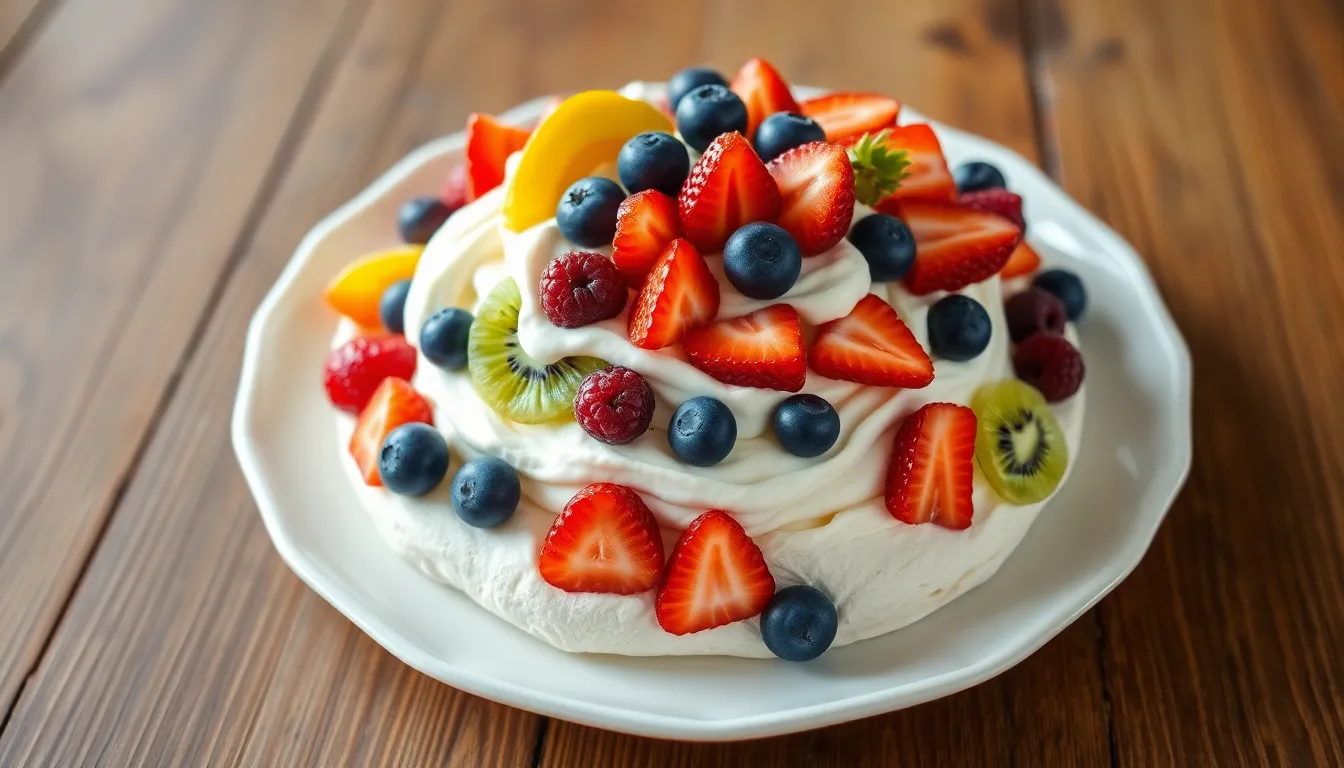
The finishing touches on your pavlova transform it from a simple meringue into a showstopping dessert. Adding colorful toppings not only enhances the visual appeal but also creates delightful flavor contrasts with the sweet crisp shell and marshmallowy center.
Fresh Fruit Options
Fresh fruits make the perfect topping for your gluten free pavlova as they add vibrant colors and complementary flavors. Strawberries bring a sweet tartness that pairs wonderfully with the meringue’s sweetness. Kiwi slices offer a tropical tang and striking green color contrast against the white pavlova. Passionfruit pulp drizzled over the top provides an exotic flavor burst and visually stunning presentation. Blueberries and raspberries contribute both color and antioxidant-rich goodness to your dessert. These fruit options are all naturally gluten free which makes them ideal for maintaining the integrity of your gluten free dessert. You can arrange these fruits in artistic patterns or simply pile them generously on top of the whipped cream layer.
Whipped Cream Topping
Freshly whipped cream creates the perfect foundation for your fruit toppings while adding a rich creaminess that balances the pavlova’s texture. For the best results, use cold heavy cream and chill your mixing bowl beforehand to achieve maximum volume. Whip the cream until it forms soft peaks that hold their shape but still maintain a silky smoothness. Adding a small amount of vanilla extract and a light dusting of powdered sugar enhances the cream’s flavor without overwhelming the delicate meringue. The whipped cream layer should be spread generously across the top of your cooled pavlova just before serving to prevent the meringue from becoming soggy. Heavy cream contains no gluten which makes this traditional topping perfectly safe for those with celiac disease or gluten sensitivity.
Tips For Perfect Gluten Free Pavlova

Creating the perfect gluten-free pavlova requires attention to detail and proper technique. These essential tips will help you achieve that signature crisp exterior and marshmallow-soft interior that makes pavlova so irresistible.
- Use room temperature egg whites for maximum volume and stability in your meringue
- Select superfine (caster) sugar or grind granulated sugar finely to ensure smooth texture without grittiness
- Add cornstarch to absorb moisture and create that characteristic marshmallow center while maintaining gluten-free status
- Incorporate a small amount of cream of tartar or lemon juice to stabilize your meringue and prevent collapse
- Bake at a low temperature gradually to develop the perfect crisp shell while keeping the inside soft and pillowy
Avoiding Cross-Contamination
When preparing gluten-free pavlova, preventing cross-contamination is crucial for those with celiac disease or gluten sensitivity. Verify all ingredients and toppings are certified gluten-free, especially vanilla extract and whipped cream, as some commercial products contain gluten or are processed on shared equipment. Designate clean, dedicated utensils, bowls, and baking trays specifically for gluten-free baking to eliminate contamination risks. Wipe down all countertops thoroughly before beginning your pavlova preparation. Store ingredients in separate containers away from gluten-containing products in your pantry. Remember that even tiny amounts of gluten can cause reactions in sensitive individuals, so these precautions are essential for truly gluten-free desserts.
Storage Guidelines
Pavlova tastes best when served fresh on the day it’s made, as humidity gradually softens its crisp exterior. You can store the baked meringue base in an airtight container at room temperature for up to 2 days before adding any toppings. Once topped with cream and fruit, refrigerate your pavlova and consume it within 24 hours for optimal texture and freshness. Avoid freezing pavlova as this compromises its delicate texture and structure. Place your stored pavlova away from strongly aromatic foods since meringue easily absorbs surrounding odors. For serving leftover pavlova, allow it to come to room temperature for about 20 minutes to enhance its flavor profile and texture.
Common Mistakes To Avoid
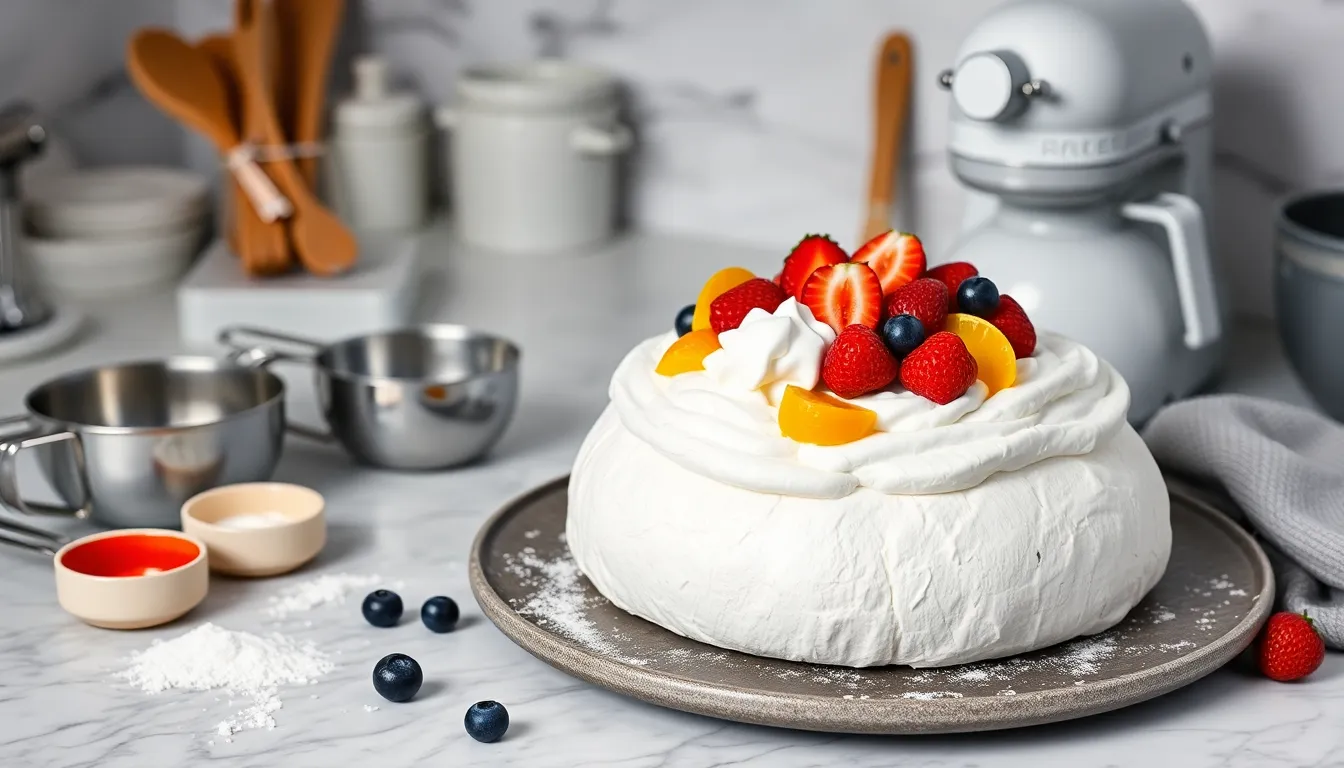
Creating the perfect gluten-free pavlova requires attention to detail. Even small errors can impact the texture and safety of your dessert. Watch out for these common pitfalls when making your pavlova:
Cross-Contamination Issues
Kitchens often harbor hidden gluten sources that can compromise your pavlova. Always thoroughly clean your mixing bowls, beaters, and spatulas before use. Dedicated baking equipment for gluten-free cooking provides the safest option. Never use utensils that have previously touched wheat-based products without washing them first. Remember that shared sifters, measuring cups, and baking sheets can transfer gluten particles to your ingredients.
Ingredient Selection Problems
Using baking powder instead of cornstarch represents a major mistake when making gluten-free pavlova. Traditional baking powder often contains wheat starch as an anti-caking agent. Always select pure cornstarch as your thickening agent. Verify that your vanilla extract contains no gluten-based additives or artificial flavorings. Read labels carefully on any pre-packaged ingredients such as cream of tartar to ensure they haven’t been processed in facilities that handle wheat products.
Topping Troubles
Many pavlova failures occur at the final stage—adding toppings. Some fruit sauces and glazes contain modified food starch that may include gluten. Commercial whipped creams sometimes incorporate stabilizers with hidden gluten. Chocolate shavings or cookie crumbles used as decorative elements frequently contain wheat flour. Stick with fresh fruits and homemade whipped cream to guarantee your pavlova remains completely gluten-free. Check any store-bought toppings for potential gluten contamination before adding them to your dessert.
Meringue Texture Missteps
Allowing any fat to contact your egg whites will prevent proper meringue formation. Even a tiny drop of egg yolk can ruin your pavlova base. Using a plastic bowl rather than glass or metal can also compromise your meringue because plastic surfaces often retain traces of fat. Adding sugar too quickly prevents it from dissolving properly and creates a grainy texture. Always add sugar gradually while continuing to beat the egg whites. Overbeating your meringue after adding cornstarch leads to a deflated pavlova that won’t maintain its structure.
By avoiding these common mistakes, you can create a perfectly safe and delicious gluten-free pavlova every time. Your attention to these details ensures both celiac-friendly results and the ideal crisp exterior with marshmallow-soft interior that makes pavlova so special.
Variations Of Gluten Free Pavlova
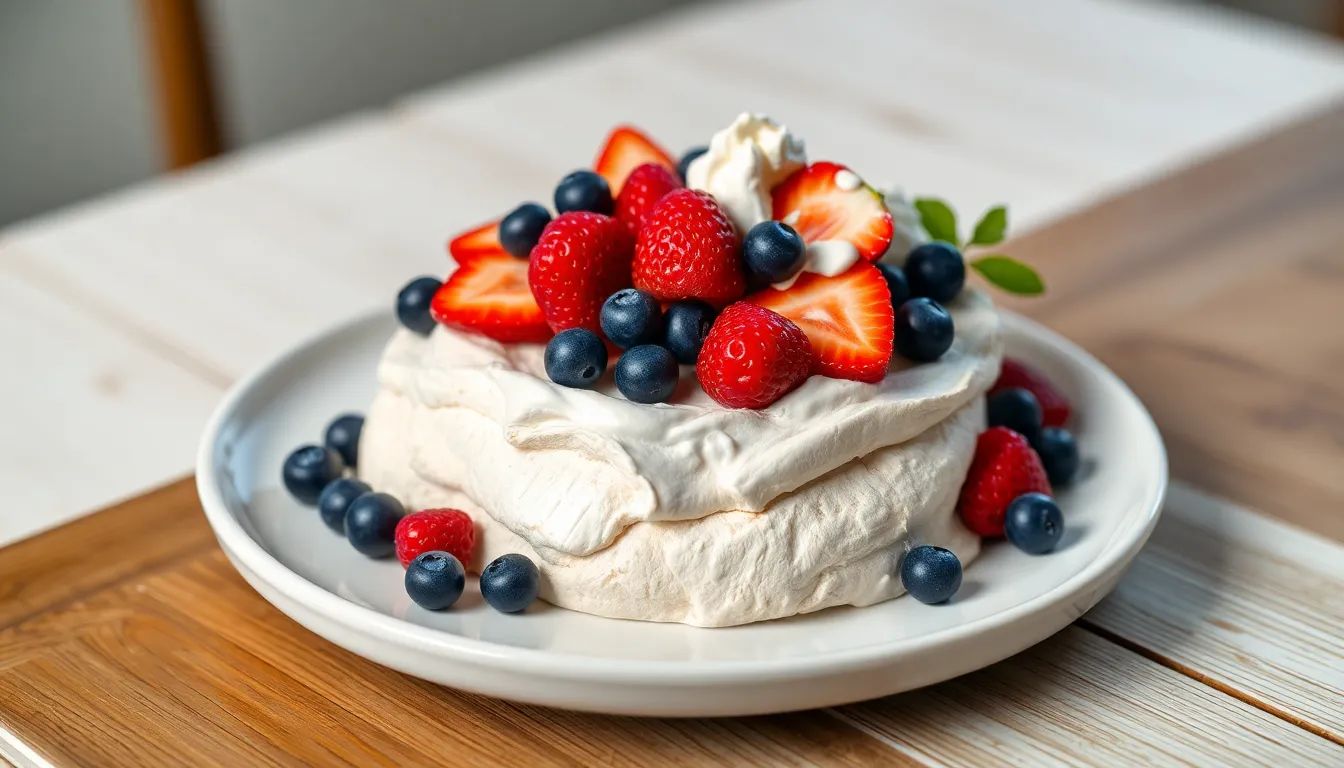
Pavlova’s natural gluten free status makes it an incredibly versatile dessert that can be adapted in many ways while maintaining its safe status for those with celiac disease or gluten sensitivity. The basic meringue foundation allows for creative interpretations that cater to different tastes and occasions.
Classic Fruit Pavlova
The traditional version features a basic meringue base made with egg whites, superfine sugar, cream of tartar, vanilla extract, and cornstarch. This combination creates the signature crisp exterior and soft marshmallow interior that pavlova is known for. Top this classic version with freshly whipped cream and a medley of berries such as strawberries and blueberries for a timeless presentation.
Chocolate Pavlova
Transform your basic pavlova into a chocolate lover’s dream by adding 2-3 tablespoons of unsweetened cocoa powder to your meringue mixture. The cocoa powder integrates perfectly with the egg whites and sugar while maintaining the gluten free integrity of the dessert. Pair this rich variation with chocolate whipped cream and fresh raspberries for an indulgent treat.
Mini Individual Pavlovas
Instead of creating one large pavlova create several smaller portions by spooning the meringue mixture into 3-4 inch circles on your baking sheet. These individual servings make elegant dinner party desserts and allow guests to customize their own toppings. The smaller size also reduces baking time to approximately 45 minutes rather than the traditional 60-75 minutes.
Tropical Pavlova
Give your pavlova an exotic twist by topping it with tropical fruits like mango slices kiwi passion fruit and pineapple. The tartness of these fruits beautifully balances the sweetness of the meringue. Add a sprinkle of toasted coconut flakes (verify they’re gluten free) for additional texture and tropical flavor.
Lemon Curd Pavlova
For a tangy variation spread homemade lemon curd between the meringue base and whipped cream. Ensure your lemon curd is made with gluten free ingredients including cornstarch rather than flour as a thickener. The bright citrus flavor creates a delightful contrast with the sweet meringue and can be garnished with fresh blueberries for visual appeal.
Nut-Enhanced Pavlova
Fold 1/2 cup of finely chopped nuts such as almonds or hazelnuts into your meringue mixture before baking. Always verify the nuts are processed in a gluten free facility to avoid cross-contamination. This addition introduces a subtle nuttiness and enhanced texture to the pavlova while maintaining its gluten free status.
Seasonal Variations
Adapt your pavlova to showcase seasonal fruits:
- Summer: Fresh berries peaches and cherries
- Fall: Poached pears apple compote and cinnamon whipped cream
- Winter: Citrus segments pomegranate arils and mint
- Spring: Strawberries rhubarb compote and edible flowers
Each seasonal variation allows you to enjoy this naturally gluten free dessert year-round while taking advantage of the freshest available produce.
Remember that regardless of which variation you choose always verify that any additional flavorings or toppings such as extracts sauces or decorative elements are certified gluten free to maintain the integrity of this naturally wheat-free dessert.
Serving Suggestions
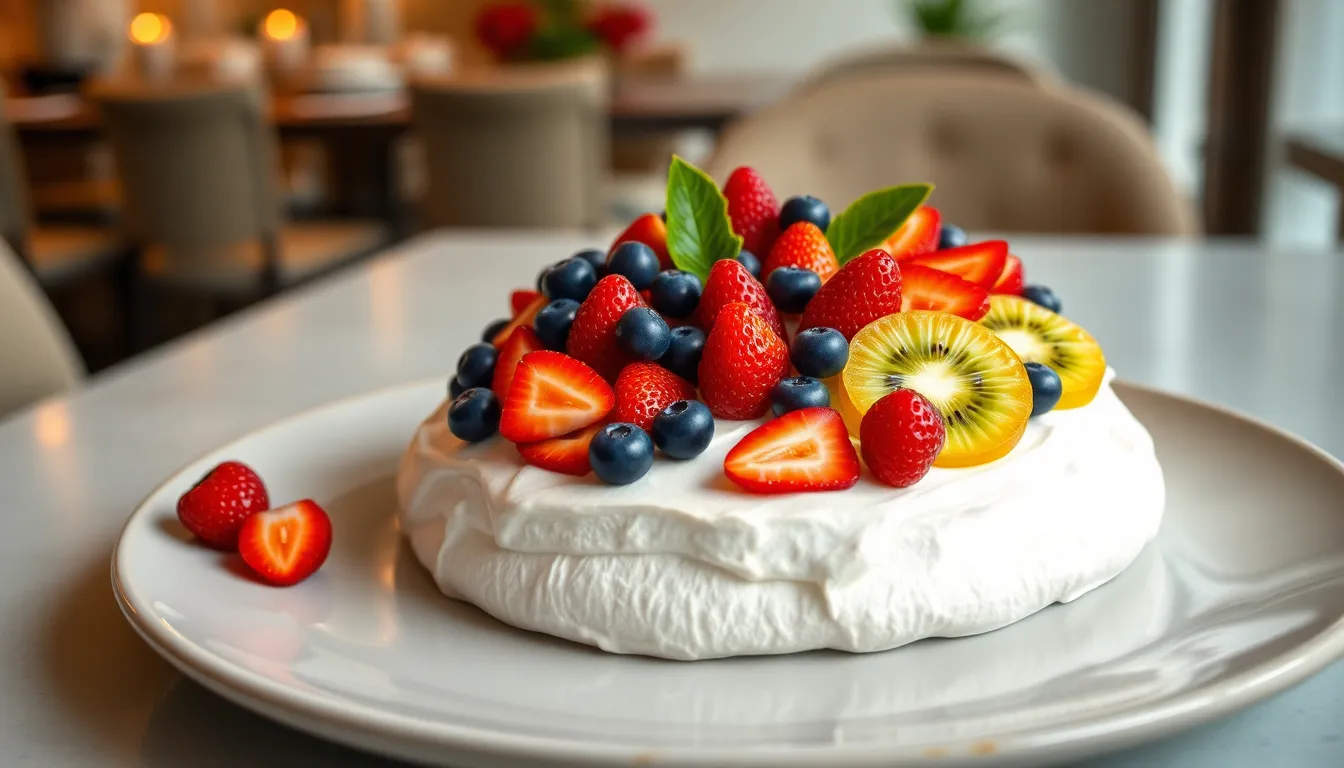
Pavlova shines as the centerpiece of any dessert table with its impressive appearance and delightful textures. Present your gluten-free pavlova on a flat serving plate with a slight rim to contain any juices from the fruit toppings. The contrast between the white meringue and colorful fruits creates a visually stunning presentation that will impress your guests.
Serve pavlova immediately after adding toppings to maintain the crisp exterior and marshmallowy interior. The dessert begins to soften once topped with cream and fruits which affects its signature texture. For the best experience let the pavlova cool completely before adding any toppings.
Fresh seasonal fruits work wonderfully as accompaniments to your gluten-free pavlova. Summer berries like strawberries blueberries and raspberries provide vibrant color and tangy flavor. Tropical fruits such as kiwi mango and passion fruit add exotic flair while still maintaining the gluten-free integrity of the dessert.
Consider serving your pavlova with complementary sauce options on the side. Passion fruit pulp drizzled over the top adds a tangy contrast to the sweet meringue. Berry coulis made from pureed strawberries or raspberries offers a beautiful color accent and flavor enhancement while remaining safely gluten-free.
Pavlova pairs excellently with hot beverages like coffee or tea which balance the sweetness of the dessert. For special occasions a glass of champagne or sparkling wine creates an elegant combination with this naturally gluten-free treat.
When hosting guests with various dietary needs pavlova proves particularly versatile. You can easily create a serving station with the plain meringue base and various toppings allowing guests to customize their portions. This approach works especially well for those with additional dietary restrictions beyond gluten sensitivity.
For formal gatherings individual mini pavlovas offer an elegant single-serving option. These smaller versions maintain all the gluten-free benefits of the traditional dessert while providing a sophisticated presentation. Plate each mini pavlova with a sprig of mint for a professional finish.
Final Thoughts On Gluten Free Pavlova
Pavlova stands as a perfect example of a naturally gluten-free dessert that doesn’t compromise on taste or presentation. With its crisp exterior and marshmallowy center topped with fresh fruits and cream you’ll create an impressive dessert that’s safe for those with celiac disease or gluten sensitivity.
Making pavlova at home gives you complete control over ingredients ensuring a truly gluten-free experience. The simple combination of egg whites sugar cornstarch and vinegar creates a dessert that’s both elegant and accessible to bakers of all skill levels.
Whether you’re preparing a classic version or experimenting with chocolate tropical or mini variations pavlova offers endless possibilities while remaining gluten-free. Just remember to use dedicated equipment clean tools and certified gluten-free ingredients for a safe delicious treat everyone can enjoy.
Frequently Asked Questions
Is pavlova gluten-free?
Yes, traditional pavlova is naturally gluten-free. It’s made with egg whites, sugar, cornstarch, and vinegar or cream of tartar – all ingredients that contain no gluten. This makes it an excellent dessert option for people with celiac disease or gluten sensitivity, provided it’s prepared in a clean, cross-contamination-free environment.
What are the main ingredients in pavlova?
The main ingredients in pavlova are egg whites, superfine sugar, cornstarch, white vinegar or cream of tartar, and vanilla extract. All these ingredients are naturally gluten-free. The egg whites create the structure, sugar adds sweetness, cornstarch helps achieve the marshmallow-soft center, and vinegar or cream of tartar stabilizes the meringue.
Where did pavlova originate?
Pavlova originated in either Australia or New Zealand during the 1920s. It was named after the Russian ballerina Anna Pavlova following her tour to these countries. Both nations claim to be the birthplace of this dessert, and the debate remains unresolved. Regardless of its exact origin, pavlova has become a cultural icon in both countries.
How do I prevent my pavlova from cracking?
To prevent pavlova from cracking, avoid rapid temperature changes. Preheat your oven properly, bake at a low temperature (around 250°F/120°C), and after baking, turn off the oven and leave the pavlova inside with the door slightly ajar to cool gradually. Also, avoid overbeating your egg whites and don’t open the oven door during baking.
Can I make pavlova ahead of time?
Yes, you can make the meringue base 1-2 days ahead of time. Store it in an airtight container at room temperature. However, only add whipped cream and fruit toppings right before serving to prevent the meringue from becoming soggy. The contrast between the crisp shell and soft interior is best experienced when freshly assembled.
Is store-bought pavlova safe for people with celiac disease?
Store-bought pavlova may not be safe for people with celiac disease due to potential cross-contamination during manufacturing. Always check labels carefully for gluten-free certification. For those with severe gluten sensitivity or celiac disease, homemade pavlova using verified gluten-free ingredients and clean equipment offers the safest option.
What fruits work best as pavlova toppings?
The best fruits for pavlova toppings include strawberries, kiwi, passion fruit, blueberries, raspberries, mango, and banana. Berries are particularly popular for their vibrant colors and complementary tartness. Seasonal fruits work wonderfully, offering freshness and visual appeal. For added flavor, consider drizzling with fruit coulis or passion fruit pulp.
How do I know when my pavlova is properly baked?
A properly baked pavlova should be crisp and dry on the outside with a slight beige tint, while remaining marshmallow-soft inside. It should feel light and dry to the touch and lift easily from the parchment paper. The exterior should not be sticky. Typically, this takes about 60-90 minutes at a low temperature (250°F/120°C).
What’s the difference between pavlova and meringue?
While both are egg white-based desserts, pavlova contains cornstarch and vinegar, giving it a marshmallow-soft center beneath its crisp exterior. Traditional meringue is crisp throughout. Pavlova is typically cake-sized and topped with whipped cream and fruit, while meringues are often smaller cookies or shells. Pavlova also has a chewier texture inside.
Can I freeze pavlova?
You can freeze the baked, unfilled pavlova base for up to one month, wrapped carefully in plastic wrap and stored in an airtight container. However, once topped with cream and fruit, pavlova cannot be frozen successfully. Thaw the frozen base at room temperature before decorating with fresh toppings just before serving.
